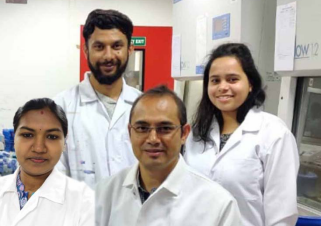Lyse – Fill with DNA – Reseal: New method to make genetic alterations in malaria parasite
Date : సెప్టెంబర్ 24, 2024

WHO estimates 3.4 billion people across 92 countries in the world to be at risk of being infected with Plasmodium parasites and suffering from malaria. A statistic as alarming as this makes it imperative to study the parasite biology with a focus on understanding the functions of parasite’s genesand identify targets for development of drugs and vaccines. Gene delivery into the target cells is a popular choice to manipulate and study gene functions. However, there are several technical challenges in studying genes of Plasmodium parasites.
Plasmodiumcauses malaria when it grows in the oxygen-carrying Red Blood Cells (RBCs) in our body. While growing inside the RBCs protects the parasite, it poses a huge challenge to malaria biologist as one has to cross through 4 membrane layers to reach the Plasmodium’s genes. A widely used method to manipulate genes is electroporation. This is, however, a resource-intensive technique employed to create pores in the cell membrane using electricfieldfor passage of desired chemicals like DNA. Dr Puran Singh Sijwali’s group at CSIR-Centre for Cellular and Molecular Biology, Hyderabad works with Plasmodium falciparum, which is responsible for the majority of severe cases of malaria and deaths. Theyhave developed a novel and economic way of gene delivery within thePlasmodium falciparumcells, called the Lyse-Reseal method.
RBCs open up or lyse when they are in hypotonicsolutions (with salt concentration lower than inside the cell). This allows them to fill in the lysed RBCs with circular DNA of their choice. Increasing the salt concentration in the solution again lets them close the RBCs called resealed RBCs. They infected the resealed RBCs containing the DNA of interest with Plasmodium falciparum. The parasite goes inside the RBC and passively takes up the DNA from the RBC. The DNA eventually ends up in the parasite’s nucleus with its own genes.The group has shown the technique to be as effective as electroporation with 2 different Plasmodium falciparum strains, and works with 10 times lesser DNA than what is needed in electroporation. The main advantage of their method is that it does not require an expensive electroporation device and other proprietary accessories. Hence, it can be used forPlasmodium falciparum genetic studies even in low-resource labs, which is usually a case in the regions endemic for malaria.
They also have demonstrated that RBCs of blood group O+provide the most efficient delivery of DNA into Plasmodium falciparum in vitro. This study has been recently published in Scientific Reports.
“Ease of making genetic alterations in the parasite will help in better understanding the biology of malaria pathogen and, thereby, help in control of the malaria parasite better”, says Dr. Rakesh Mishra, Director, CCMB


 Advertisement no 07/10 for the post Junior Scientist.
Advertisement no 07/10 for the post Junior Scientist.